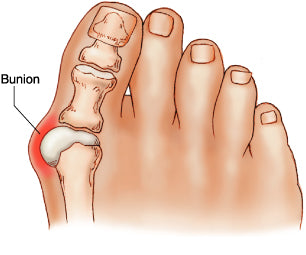Why should I care about bunions?
Posted by JB Smith, Co-Owner on
 Bunions? Isn’t that something my Grandma complains about? What does that have to do with me? Well, actually, you should educate yourself on bunions, as they do develop over time and if caught early can be avoided. It is also more likely that you are prone to them if your Grandma has them, too!
Bunions? Isn’t that something my Grandma complains about? What does that have to do with me? Well, actually, you should educate yourself on bunions, as they do develop over time and if caught early can be avoided. It is also more likely that you are prone to them if your Grandma has them, too!
You may imagine bunions as an affliction for the elderly or those that don’t take care of their feet. It certainly isn’t something we talk about often. But nearly a third of the US population develops them. Are you familiar with what a bunion actually is?
At first, a bunion may just look like a red bump on the side of your foot at the base of the big toe. It may look like your big toe is leaning towards the other toes. But it is actually a joint or bone misalignment, that, when developed, causes painful inflammation that affects both foot health and comfortable walking.
Certain types of shoes are specifically known to cause bunions. A heeled shoe forces weight down onto the toes while a narrow toebox shoves them together at an angle. Shoes such as pointy toed heels or cowboy boots put just the right pressure on the big toe joint and make the development of bunions likely. But there are other, less exaggerated shoe styles that will exacerbate bunions, too.
Studies have discovered that in countries without Westernized shoe styles the occurrance of bunions drops from 30% to 3%. This suggests that while not all people can or will develop bunions, those that are more likely to can manage their risk. Heredity is also an important risk factor.
We can begin to control the damage to our feet with healthy shoe choices. Wearing shoes with no more than 2 inches of heel height, and shoes that distribute the pressure of your body weight evenly across the entire bottom of your foot, are the most important steps to avoid bunions. If you have started to notice inflammation or tenderness, come into SHOES-n-FEET to be fitted into a pair of shoes that will allow your toes room to splay naturally and not cause further problems. Over the counter arch supports can also assist your foot from devoloping bunions.
The next step in a mild case of bunions is treated with a flexible splint that helps stabilize the arch and keeps the big toe away from the other toes at the correct angle. By walking this way, with the splint, the foot is strengthened. Simple foot exercises may also aid in the strengthening and prevention of bunions or hammertoes.
The take-away; keep an eye out for the beginning symptoms of bunions, like a red, irritated big toe joint or a bent big toe, so that you can combat bunion development by treating your feet thoughtfully. For more information, click here.
